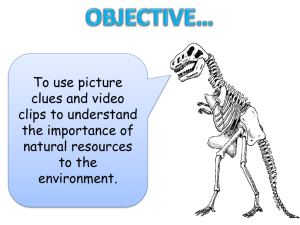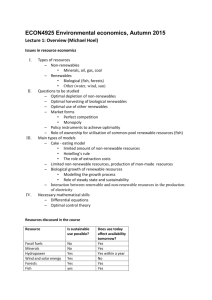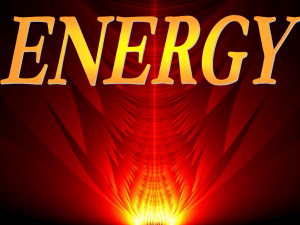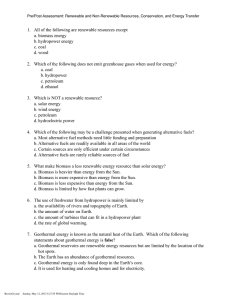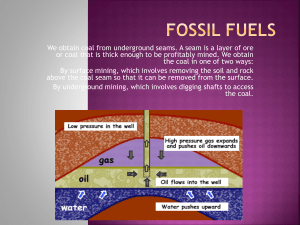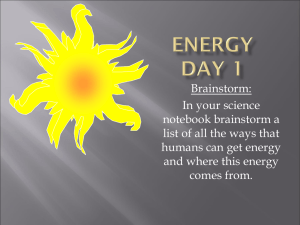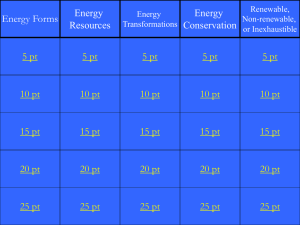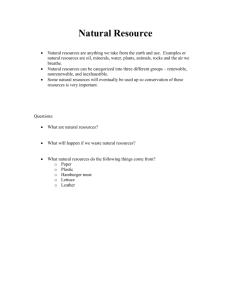Student Worksheet on Energy Resources
advertisement
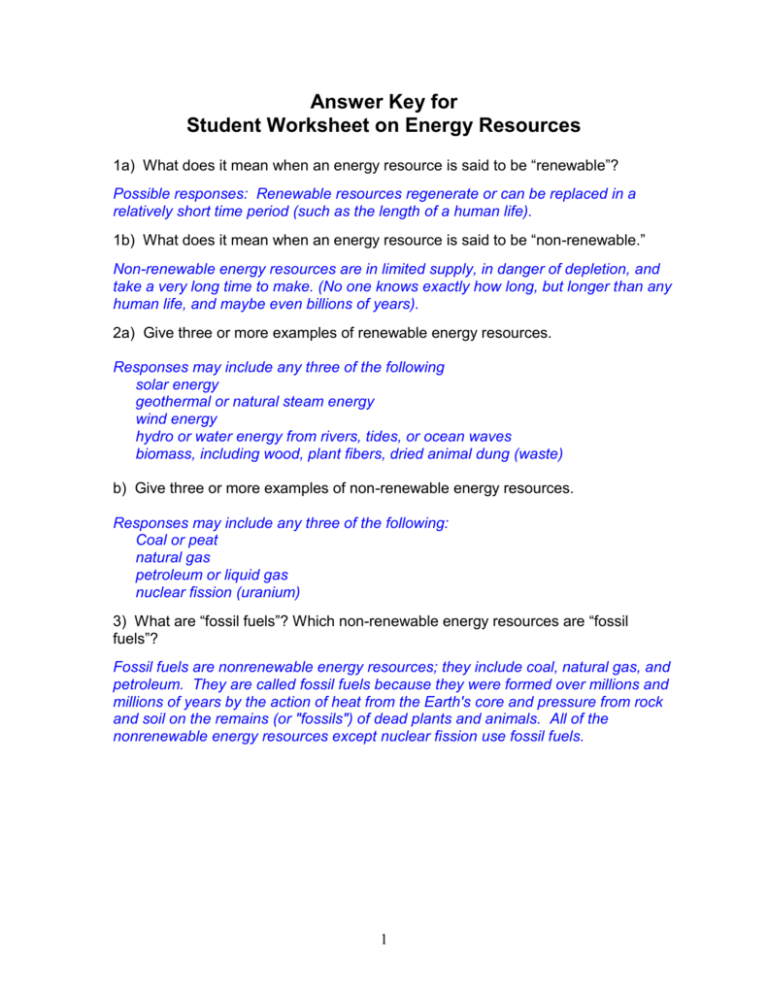
Answer Key for Student Worksheet on Energy Resources 1a) What does it mean when an energy resource is said to be “renewable”? Possible responses: Renewable resources regenerate or can be replaced in a relatively short time period (such as the length of a human life). 1b) What does it mean when an energy resource is said to be “non-renewable.” Non-renewable energy resources are in limited supply, in danger of depletion, and take a very long time to make. (No one knows exactly how long, but longer than any human life, and maybe even billions of years). 2a) Give three or more examples of renewable energy resources. Responses may include any three of the following solar energy geothermal or natural steam energy wind energy hydro or water energy from rivers, tides, or ocean waves biomass, including wood, plant fibers, dried animal dung (waste) b) Give three or more examples of non-renewable energy resources. Responses may include any three of the following: Coal or peat natural gas petroleum or liquid gas nuclear fission (uranium) 3) What are “fossil fuels”? Which non-renewable energy resources are “fossil fuels”? Fossil fuels are nonrenewable energy resources; they include coal, natural gas, and petroleum. They are called fossil fuels because they were formed over millions and millions of years by the action of heat from the Earth's core and pressure from rock and soil on the remains (or "fossils") of dead plants and animals. All of the nonrenewable energy resources except nuclear fission use fossil fuels. 1 Hydropower 7% Nuclear power 20% Geothermal power, solar power,wind power, biomass 2% Coal 52% Petroleum 3% Natural gas 16% Capacity to Generate Electricity by Energy Source, in the U.S. Source: United States Energy Information Admin 4. According to the chart above, what percentage of US energy is produced by all of the nonrenewable sources, combined? Show your calculations. Coal + nuclear power + natural gas + petroleum = 52% + 16% + 20% + 3% = 91% 5. a) What energy resource is most commonly used to make electricity? Coal b) Is this energy resource renewable or non-renewable? non-renewable? 6. What are the three main types of air pollutants produced by electrical power plants in the United States (in descending order, from greatest quantity to least)? 1 2 3 carbon dioxide sulfur dioxide nitrogen oxides 7. What are the three main types of air pollutants produced by electrical power plants in Georgia (in descending order, from greatest quantity to least? 1 2 3 carbon dioxide sulfur dioxide nitrogen oxides 8a) Since some air pollution comes from power plant emissions, what can one do to reduce one’s needs for electrical energy? Accept any reasonable response. Some possibilities: Use less electricity (simplify lifestyle). When electricity is used, conserve energy by using energy-efficient lighting and appliances, heat pumps for heating and cooling, etc. b) Give an example of a technology for cleaning up power plant emissions. Accept any of the following: Nitrogen oxide controls (e.g. low-NOx burners, chemical cleaners, oxygen-enhanced combustion); Mercury controls (e.g. transforming mercury gas into solids which can be trapped; gas scrubbers); Particulate controls (e.g. fabric filters, electrostatic precipitators); Coal by-product recycling; or Coolant water recycling. 2 c) What could you do to reduce the amount of gas burned (and therefore the amount of air pollution created) to get you from place to place? Accept any of the following: By taking alternative forms of transportation (bike, walk, vanpool or carpool, mass transit); by reducing travel (i.e. teleworking from home, working an alternate schedule or compressed work week- such as four 10-hour days, making fewer trips by combining errands);by switching use of vehicles from peak to offpeak hours (i.e. working flextime; pumping fuel after dark); buying local products to reduce needs for long-distance transportation 9a What are three benefits or advantages of hydropower? (Accept any three of the following) 1. clean energy source which does not emit air pollutants 2. renewable energy source, with virtually unlimited supply 3. relatively inexpensive to produce power; 4. recreational reservoirs; 5. high capacity for handling peak loads 9b. What are two limitations or disadvantages of hydropower? (Accept any 2 of the following) 1. environmental impacts; such as dam interrupting salmon spawning 2. flatlands do not have enough elevation change for hydropower to work (as in most parts of Florida) 3. potential conflicts of use with farmers who need water to irrigate 10a. Draw a diagram of a hydroelectric dam and powerhouse, using the back of this page, and label the following: reservoir, intake, penstock, turbine, generator, powerhouse, electrical lines. See diagram at either Web site for correct labeling of hydroelectric dam and powerhouse: http://www.energyquest.ca.gov/story/chapter12.html http://people.howstuffworks.com/hydropower-plant.htm b. Which part of a generator corresponds to a water wheel? Turbine 3


